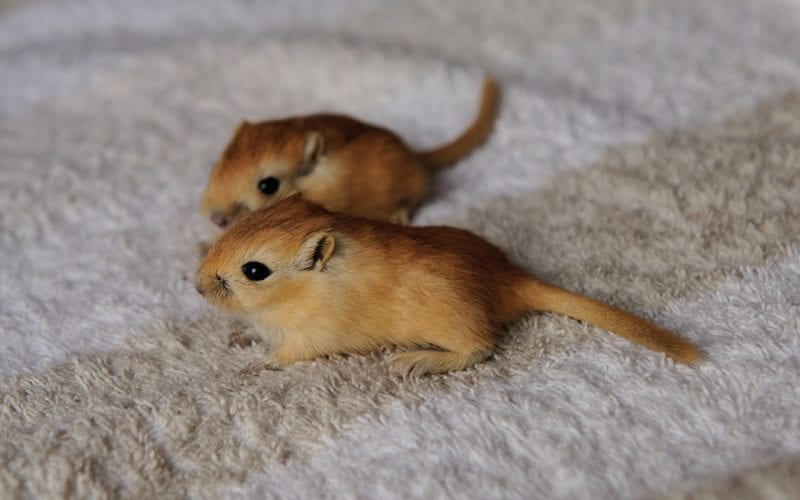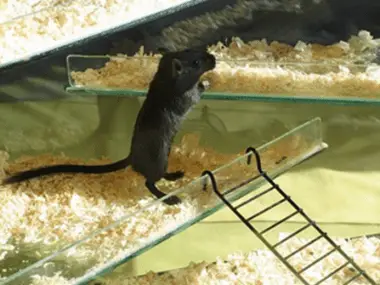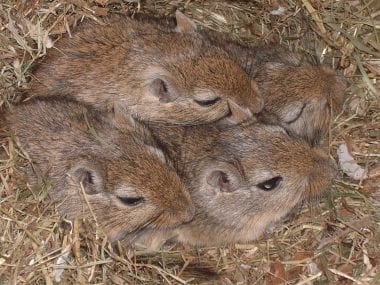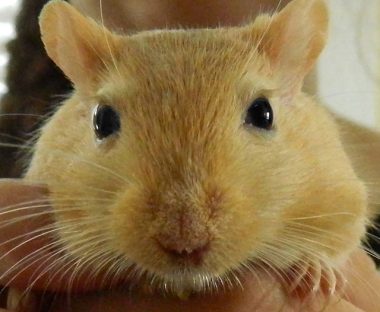The different colors of gerbils are due to genetics and selective breeding. There are forty different colors of colors all over the world, some being more common than others, while others are rarer. Apart from different colors, there are different patterns as well.
Do Gerbils Change Color?
The changes in gerbil color occur due to age. It is a frequent phenomenon observed among many kinds of gerbils. In childhood, the color and pattern may be lighter and becomes more pronounced in adulthood. Change of gerbil color is also observed from adulthood to old age, in which the color seems to fade. This is an absolutely normal part of aging. It must be understood that gerbil colors and patterns cannot completely change; they only get darker or lighter.
Different Colors of Gerbils
Agouti
Agouti is the wild color of the gerbils, constituted by a mix of brown, gray, and orange fur. An agouti gerbil’s eyes are black and its skin is pinkish-grayish with lighter pink arms. Its fuzz is brown with black on top. It retains its color throughout its life. There can be variations in their color, depending on the recessive genes they carry.
Argente Golden

Argente Golden is a deep yellow or beige color of gerbils, having red eyes and white bellies. Quite a lot of difficulty may emerge when trying to differentiate Argente Golden from Argente Cream and Topaz gerbil colors. The Argente Golden is differentiated by having some gray beneath its golden fur and/or at the tip of its golden tail. Argente Golden colored gerbil has pink eyes. After some days of age, a grey is seen along with the yellow on its back.
Argente Cream

Argente Cream looks similar to the Argente Golden gerbil color, but it is lighter, with red eyes and a white belly. The skin retains its pink color longer than the Argente Golden and Topaz gerbil colors before it turns yellow/cream color.
Topaz
Topaz is the gerbil color in between Argente Golden and Argente Cream gerbil colors. Differentiating between the three is an extremely difficult task! The method to tell them apart is that between the three different gerbil colors, Argente Cream is the lightest. The Argente Golden has some gray at the tip of its tail, and Topaz doesn’t. It has red eyes and a white belly.
Black
Black is like its name, completely black except for the front paws and under the chin, which may have white marks (the main characteristic of black gerbils). The eyes and belly are also totally black. Occasionally the black gerbil color might appear to be slate color. It may be gray or brown for a short while after the birth with a pink belly, however, it will begin to darken. It has a black and shiny fuzz.
Lilac
Lilac consists of a plain dark gray, with white marks on the chin and also on the paws as seen in the black gerbil, with red eyes. The back and the belly are the same color as each other. It has a prominent gray color compared to any of the Argente gerbils or Doves. Fuzz appears gray and slightly purplish in nature.
Sapphire
Sapphire color is an even gray color and comes in between Dove and Lilac. This color is lighter than the previous one, this causes confusion with Dove, especially in young gerbils. It is somewhat bluish the way lilac is purplish. It has pink eyes and darker gray on its head.
Dove
It’s a very light and very nice shade of gray, with red eyes and an equally gray back and belly. Compared to lilac the gray color is softer. A baby dove is going to be pink for sometime until it turns white. Then it will take another while for the gray to become more apparent.
Ruby Eyed White
Ruby Eyed White is completely white with red eyes. The skin is initially pink. It stays that way for sometime before the white fur grows in.
Dark Tail White
Dark Tail White is completely white for the first 4 to 6 months after which only its tail becomes dark. Before that, it is impossible to tell if a gerbil is a dark-tailed white except for knowing the parent’s genetic code.
Dark Eyed Honey
Dark Eyed Honey is a pronounced orange color, with black almond-shaped eyes. Its stomach is white-colored, and the color continues till the higher end as compared to an agouti gerbil. The babies bear the usual dark pigmentation right near its eyes, ears, and extremities while the remaining portion of its skin is of pink color everywhere else. It has an orange fuzz that may stay the same or become darker as time passes.
Honey Cream
Honey Cream is a creamy white color with a little bit of orange color on the back. It has a white colored shape of diamond right on its forehead. It has black eyes and a white belly. The skin surrounding its ears and the eyes are black in color, but its paws remain pink.
Nutmeg
Nutmeg is brown with black ticking and beneath there’s an orange undercoat which can be seen by pushing the fur back. There’s no difference in the body and belly color and it has black eyes. It’s seen clearly after the molting at 2 months of age, one of the most astounding molts of gerbils.
Spotted
Spotted gerbils usually just have a small diamond present on their forehead. However, sometimes they may have a small amount of white on the neck which doesn’t extend beyond the neck to the shoulder level.
Pied
Pied gerbils have markings on the forehead and neck which extend down to their shoulders. and to their front paws. There is some possibility of white markings being visible on their lower back as well.
Mottled
Mottled gerbils will have a greater amount of white markings than the Pied gerbils including more pronounced lower back markings.
Heavy Mottled
Heavy Mottled gerbils have an increased amount of white markings as compared to the Mottled ones. In extreme cases, it is almost not possible to classify the actual color of the gerbil.







